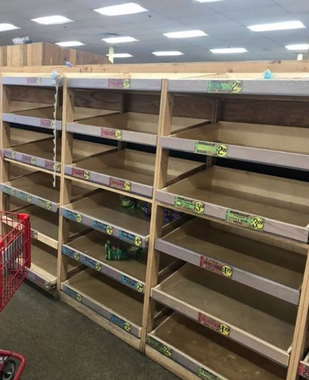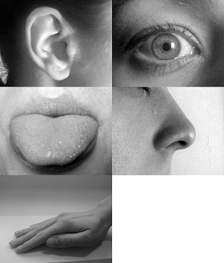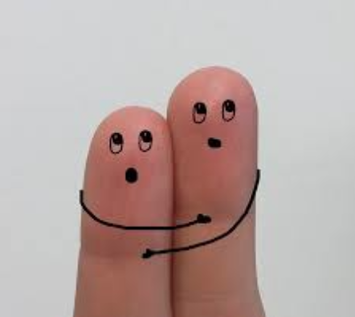 On a walk today I had some thoughts about anxiety and presence that I wanted to share with you. I made two videos to capture the insights. Thanks to my wiley Lab puppy, Luna, I also stumbled across this snake skin. She was initially drawn to it, then reared back like it would bite her. Instinct at play. It looks like a child's discarded sock and reminded me of how close we are to our natural animal instincts. How might we move about our day if we but listen to the wise, soulful stream of ideas that are available to each of us if we pay attention? What will it take for you to shed old beliefs, fearful eddies that may have captured your boat for too long? What does true transformation look like for you? Here are the two videos...
1 Comment
 About a month ago, before shelter-in-place took effect in my town of Petaluma, I went to Trader Joe's to buy food for the week. I knew things were changing. There was the coronavirus devastating China and speculation about its spread to the United States. But I was unprepared for what I discovered in the store: empty shelves, crowded aisles full of frantic shoppers throwing things in their cart, and a feeling of strangeness in my own body, like I was watching events unfold on television or a movie. What I kept repeating to myself, and to anyone who would listen was simply, "This is crazy." The other shoppers were too busy finding their items to pay much attention. But I made eye contact with many of the staff at the store and repeated my mantra, "This is crazy." We looked at each other in disbelief, trying to take it all in, and found comfort in a shared overwhelm. Since then, things have gotten worse. The state is on lockdown. We don't know when things will go back to normal, or if things will ever be "normal" again. But human beings are resilient and adaptable. I've become accustomed to my days. Working via video sessions with clients, shopping only when necessary with a mask and gloves, daily long walks steering clear of others, scheduled zoom calls with family and friends. There are the difficult days, when fear wakes me up in the middle of the night, or when sadness washes through me for all that has been lost, for those that will lose their lives today, or tomorrow, or next week, or for the many who won't have the means to buy food, pay for healthcare, or pay their rent in the coming months. One of the sustaining tools I use to help me put one foot in front of the other in times of difficulty is a simple practice. Just one thing. Slow down. I know that doesn't sound like much. But when put into practice once, and then again, and then another time throughout the day, whatever is happening still happens, but there is a little more of me inside myself to experience it. I'm not going through the motions or waiting for the moment to be over but instead I notice my feet moving down the hallway and the pressure of my socks against my heels; I notice breath moving my belly and chest, I notice the presence of an inner witness to thoughts, sensations, feelings, which become sharper and more alive. After doing this for some time, my body relaxes and I even begin to enjoy the task in front of me. The flow of warm water running over my hands while doing dishes, the softness of my puppy's ears, the smell of the jasmine blooming in the yard. The only thing we truly have is this moment and the more we can cultivate living in it, the more livable existence becomes. No matter what. So remember, just one thing. Slow down.  When someone is in a state of anxiety, it’s hard to think about anything else. Sometimes the anxious thoughts are like constant background music that a person doesn’t even notice anymore, the negative noise is a never-ending thought stream that changes a person’s outlook on the day. The end result? Low self-esteem and generally feeling stressed out and terrible. Or maybe even shrinking away from people and opportunities. Pushing back against anxiety involves learning and practicing tools on a regular basis that help calm your nervous system. Learning alternatives to the hyper-vigilant, fretful state and putting them into daily practice is essential to healing from anxiety. How do you do this? You’ve probably heard it before. It’s simple, but not always easy. Bring yourself back to the present moment. There are many ways to step back into the stream of now. One simple tool is to use your senses and notice the environment around you. Okay, let’s do this. Set aside anything else you may be doing. (Yes, I know you like to multi-task, but that can contribute to your anxiety. Just one thing at a time right now.) Take a moment to look around. What do you see? Name three things, to yourself or out loud, that you see. Really see them. Notice their shape, color, volume. Would the thing or person you’re looking at be cold or warm to the touch? What would it feel like to put your cheek next to this thing? What does it smell like? Investigate what you are seeing and take in the qualities of this object. Next, notice two things that you hear. Name them to yourself or out loud. Birds, a heater, the silence (what does the silence sound like?), the clicking of someone’s computer, traffic. What do you hear in this moment? Which sounds do you like? Which do you not like? Spend a few moments with the sounds around you. Finally, notice one thing that you can touch. Say this thing out loud or to yourself: "I am touching my corduroy pants." Feel the fabric of your clothes, the hardness of a desk, the rough texture of a tree. Let your mind become your fingers, your hand, and notice what it’s like to touch something. Feel the sensations in your fingertips. Now notice how you feel. If you are still quite anxious, do this exercise again. Take more time on each section. Let yourself linger. This is a simple, but profound exercise that can be done anywhere at anytime. You can also include naming things that you can taste: a mint, a clementine. Or things you can smell: a rose, someone’s perfume. You can use any of the senses to bring yourself back into the present moment. The more you practice this exercise on a regular basis, the more benefits you will reap. Let me know what results you have… To your calm body! Meg  I can't count the number of times I've heard people with anxiety say that if someone tells them to "just breathe" or "push through it" when they are in the middle of an anxiety attack, they will scream. And it's true, few people get what it's like to have persistent anxiety and how much it affects a person's life. But the battle is not just with others. One of the first things I address when someone suffering with anxiety comes into my office is identifying steps to take better care of herself. People with anxiety often function at a very fast pace. There isn't space and time for slowing down, which means vital processes like eating, sleeping, and (yes) breathing, suffer. Make sure you are eating regularly, getting enough sleep, moving and stretching your body, listening to your intuition, and not taking on the burden of others' problems: these are all essential tools in learning to manage and even overcome anxiety. Yet true caretaking begins with a process even more fundamental. Sometimes the first step is simply learning to accept your anxiety. Anxiety sucks. There's no question. Nobody wants anxiety; nobody wants to accept it when it arrives, uninvited on your doorstep at 11 am minutes before an important work meeting, or a plan to get tea with a friend while the kids are in school. But if you refuse the anxiety, you're also refusing your true experience in the moment, and in a way, refusing yourself. This makes for a fragmented experience of being, which only exacerbates the problem. What if instead of pushing the anxiety away, you walked right up to it and embraced it? What if you said to yourself: In this moment, I have anxiety. I don't like it, but I accept it. It's here and I will make space for it, and make space in my day to deal with it. Because I am suffering like this, I will take really good care of myself. I wonder what it is I need right now? Meg Tinsley is a Marriage and Family Therapist who specializes in working with women who struggle with anxiety issues. Her offices are located in Petaluma, CA. For personalized support with your own or a loved one's anxiety, please call (707) 776-6494 for a phone consultation. Meg offers sessions in person in Petaluma, or by phone for those who live in California. Sonoma County is in the midst of a tremendous firestorm. Hundreds of people have lost their homes, or are displaced temporarily from their homes. I thought this article from the American Psychological Association might be helpful. Here's the link, and the text is below: http://www.apa.org/helpcenter/residential-fire.aspx Recovering emotionally after a residential fire Residential fires can lead to significant emotional distress in addition to possible physical injuries. Losing your home in a fire involves not only the loss of your residence, but also many other things of value such as photo albums, important documents and treasured objects. Most importantly, though, the home is your place of security, comfort and safety. After a fire, this sense of security can also be lost and can significantly disrupt the normality of daily life. Below is a description of some emotions you may experience and steps you can take to recover. Common emotional reactionsLosing a home can cause significant emotional distress. You should not underestimate the challenge of evacuation, relocation and rebuilding after a fire. It is common for people to experience several stages of adjustment including shock, anger, depression and hopelessness. Ultimately, however, people can reach a stage of acceptance and become able to move beyond disbelief, bitterness and sadness. Positive feelings can begin to re-emerge as the focus shifts towards the future. Safety, security and comfort are regained, and life moves forward once again. Recovery and copingIn the middle of a crisis, it can become difficult to take care of yourself with so many other worries preoccupying your mind. However, this is a good time to think about your personal resiliency, healing and a sense of normality. Some self-care strategies you may want to consider are:
In addition to these recommendations, APA's "Road to resilience" brochure describes steps that you can take to build resilience — the process of adapting well in the face of adversity, trauma, tragedy, threats or significant sources of stress. For more tips on how to manage stress after a fire, please visit "Recovering emotionally from disaster." If these resources are not sufficient and if you notice persistent feelings of distress or hopelessness and feel like you are barely able to get through your daily responsibilities and activities, consult with a licensed and experienced mental health professional. Psychologists are trained to help you successfully manage life's hardships and pursue a plan for a more positive and meaningful future. To find a psychologist in your area, visit APA's Psychologist Locator. Resources
|
AuthorMeg Tinsley MFT, is a psychotherapist in private practice in Petaluma, CA. She specializes in working with women to overcome anxiety. Archives
May 2021
Categories |
 RSS Feed
RSS Feed